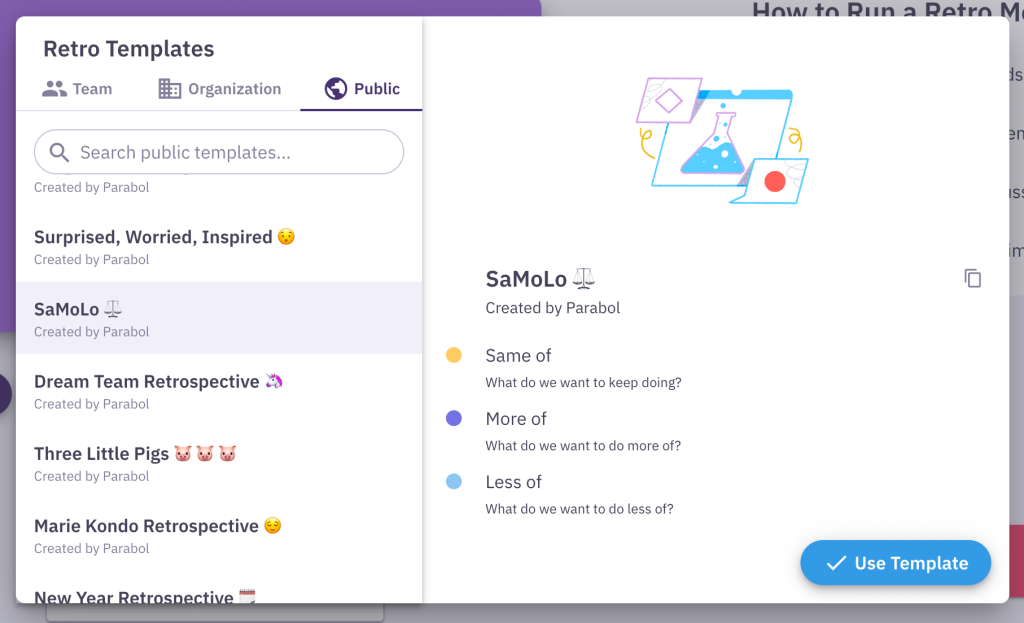SaMoLo Retrospective
Decide what to do more of, less of, and keep the same

What is a SaMoLo retrospective?
SaMoLo might sound like a musical scale, or even a type of fish. But actually, it’s neither!
SaMoLo (same of, more of, less of) is a powerful retrospective meeting. By examining how your team’s worked in the past, you can make your next iteration or sprint even better.
It might sound counterintuitive that your agile team could improve by looking backward. But by analyzing your past experience, you can understand what worked, what didn’t, and what was just perfect. Then, you can apply those lessons as you move forward!
This template can be used as a sprint retrospective, lessons learned meeting, post-mortem, or to review a project or an experience like a team retreat! The facilitator or scrum master will help everyone gather data about what they’d like to do more of, less of, and keep the same.
What are the SaMoLo retrospective prompts?
You’ll reflect together with three simple prompts. As you move through each of them, be sure to come up with concrete takeaways you can use to put them into action!
You can run this retro in person, using a whiteboard and sticky notes, or virtually with a tool like Parabol.
Same of
What was the Goldilocks of your last sprint – the technique that worked so well, you wouldn’t change a thing?
Think back on anything your team did that perfectly met your needs. This could be something you personally delivered, or a team member’s contribution.
Example: Our daily stand-up made me feel so grounded and ready to tackle the day. It was the perfect way to prepare without taking actual time away from productivity.
More of
What do you want to do more of? What approaches could you see helping your team even more, if scaled up?
These would be strategies that worked out well, but you suspect could have even broader applicability you haven’t explored!
It’s okay to get theoretical! You’ll never know how helpful these ideas could be until you try them out!
Example: I got so much value out of the 1-1s with our agile coach. This might be a crazy idea, but what if we had more of those meetings? We could try 1-1s with the developers and product owner, or even peer 1-1s between colleagues!
Less of
Close the retrospective by talking about what you could do without – or at least pull back on – in the future.
Remember, these processes don’t need to be a total failure! There’s a time and a place for everything. Wanting to do less of something doesn’t mean you think it has no value.
Don’t panic if a colleague wants to do less of something you enjoy, or if you’d like to scale back on something everyone else seems to like.
Example: I love our Kanban board for getting a big picture view of our project management timeline. But sometimes I get confused when I need a targeted, daily to-do list. Can we talk about another option for that?
When to do a SaMoLo retrospective
Try running a SaMoLo retrospective after a positive experience to double down on learnings, or to fine tune your approach to work with a new team.
After a positive experience
This agile retrospective skews towards the good things! There’s no prompt for anything that was an all-out bummer. That makes it a good fit to unpack a project that went particularly well.
A SaMoLo retro is a good opportunity to brainstorm what made the experience so special, and how you can apply those lessons going forward.
On a new team
SaMoLo is forward-facing and lighthearted. That could make it a good fit for a new team’s first retrospective together, when you’re trying things out together for the first time.
After your first sprint or project, SaMoLo can be a fun way to think about what you’d like to keep doing, what you’ll do less of, and foster some good team vibes.
How to run a SaMoLo retrospective in Parabol
Facilitators can launch a SaMoLo retrospective in Parabol by first signing up (it’s free) and then pressing the Add New Meeting button.
Select the SaMoLo retrospective template
Jump into Parabol and select Retro Meeting with the arrows, then use the dropdown to select the SaMoLo retrospective template. This is where you’ll find Parabol’s library of 40+ pre-made and customizable retrospective templates.

Start your SaMoLo retro with an Icebreaker
Every Parabol retrospective begins with an optional icebreaker. This box is checked by default. You don’t have to do one, but we recommend it.
If you’re doing an icebreaker, you’ll have a random question to answer. You can refresh it if you want another option, and of course you can create your own if you want.
Perhaps ask team members if there’s something they want more of in their lives right now!

After the icebreaker you’ll move on to the reflect stage. This is where your team will do all their ideation and brainstorm in silence using the prompts above. All reflections are kept anonymous at this stage to prevent groupthink. Parabol gives you the option to timebox this process.
All Parabol sprint retrospectives can be run synchronously or asynchronously. Functionalities such as the timer, voting and multiplayer grouping help you make your retrospective exercise a success and make facilitation easier.
Reflect, Group, and Discuss topics based on the SaMoLo retro prompts
Team members can all leave comments together, or do it at a time that works for them. Also, reflections are anonymous, and no one can see them until you’re done working on them.
After the reflect phase, you’ll vote on issues to discuss, talk about the most voted on items, and set action items for each process improvement so you can make it a reality.
Parabol will send a summary of the retro when you’re done so nobody needs to take notes.
Of course, you can do this retrospective in person, with a whiteboard or sticky notes. But it’s even easier in Parabol, especially if you’re an asynchronous or distributed team.
If you like this template, you might also like other sprint retrospective ideas that focus on what teams want more and less of. For example, try the Surprised Worried Inspired retrospective, the Highlights and Lowlights retrospective, or the classic Start Stop Continue or Mad Sad Glad format.